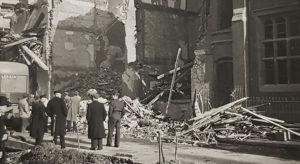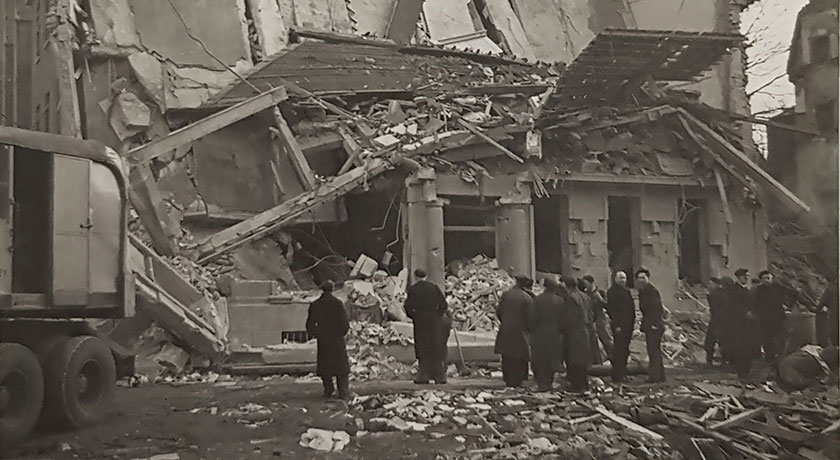Church House to mark 75th anniversary of Second World War bombing
From the URC website. The full article can be read here.
The morning of 9 February 1945 started off much like any other at Presbyterian Church House, Tavistock Place, London.
Staff arrived at their desks for a busy day of work and by the afternoon colleagues, delegates, ministers and lay people from across the country gathered for a conference with the newly formed British Council of Churches’ Department of International Friendship.
When the conference had finished, the Revd William Thorburn Elmslie, General Secretary of the Presbyterian Church of England, made his way to another appointment – a church extension committee meeting which was also being held in the building, now the central office for the United Reformed Church (URC).
He never made it.
Mr Elmslie, along with nine others – eight men and two women – died when a German V2 rocket struck the building.

To commemorate the 75th anniversary of the bombing, the URC will hold a short memorial service at Church House on 10 February at 11.30am and will display a Second World War memorial exhibition in the Madge Saunders room.
The Revd John Proctor, General Secretary of the URC, said: “War takes a terrible toll of life and hope. This rocket ended many lives, including ten people in Church House. Others had to spend time in hospital, and the building was utterly wrecked. We remember these our predecessors with sorrow, with honour, and in thanksgiving for all who work for peace in our world.”According to the National Archives, V2 rockets were first launched against England in September 1944. Launched from mobile units on the continent, each V2 rocket was 14 metres (46ft) high and carried a ton (900 kg) of explosives. The V2 was a new type of weapon, it travelled at the speed of sound and made no warning noise before impact, unlike the V1 rockets, which were also known as flying bombs, buzz bombs and doodlebugs.
Over the next few months, nearly 1,400 V2s struck London causing mass destruction and the deaths of thousands of people. They were less accurate than V1s, but since they travelled so swiftly and silently, it was almost impossible to defend against them.
The V2 was effectively the world’s first space rocket, developed during the Second World War in Germany, to attack Allied cities in retaliation for bombings against German cities. It was fuelled by liquid ethanol and oxygen and built with a powerful motor capable of propelling the rocket more than 50 miles above the earth in a trajectory of around 120 miles.
 Colleagues at the then Presbyterian Church House sadly did not stand a chance.
Colleagues at the then Presbyterian Church House sadly did not stand a chance.
Along with Mr Elmslie, those who died in the Church House bombing were:
- Alexander James Polson, Treasurer of the Publications Committee, who also served as an Elder at Ilford and then Watford.
- Ernest Henry Morris, Book-Keeper. Mr Morris had worked in the offices since he was first employed and was responsible for all book-keeping at the time of his death. He was a member at Richmond.
- George Moir, Assistant to the Financial Secretary of the Presbyterian Church of England. Mr Moir was also Treasurer at St Andrew’s, Ealing, and Treasurer to London North Presbytery.
- Ida Muriel Warner was known as the ‘voice’ of Church House as she was its Receptionist. She was the youngest of the ten, aged just 21.
- Muriel Kenyon, Book Room Assistant, and a member at St John’s Kenton.
- The Revd Reginald Herman Tribe, Minister of Anglican Society of the Sacred Mission, was attending the British Council of Churches’ Department of International Friendship meeting.
- Wilfred Henry Wright, Financial Secretary of the Presbyterian Church of England. Mr Wright had joined the staff as a school leaver and one of his responsibilities was to prepare the Report Book for General Assembly. Mr Wright also served as an Elder at Bromley PCE.
- William Thomas Stubbs, Assistant to the General Secretary. Mr Stubbs had previously held office as organising Secretary for the Youth Committee, and was an Elder at Southend.
- The Revd Thomas William Douglas James, Foreign Missions Secretary. Mr James used to fire watch at Church House and was particularly concerned for the pastoral care of families whose missionary members were interned or whose fate was unknown.
The complete casualty list for the attack came to 34 dead and 121 injured.
The threat from V2s ended in 1945 after the British army and their allies advanced across France, Belgium and Holland, capturing the launch sites.
Pictures: Bomb damage to and around Presbyterian Church House facing Wakefield Street/Courtesy of The National Archives HO 192/764
Published 4 February 2020
